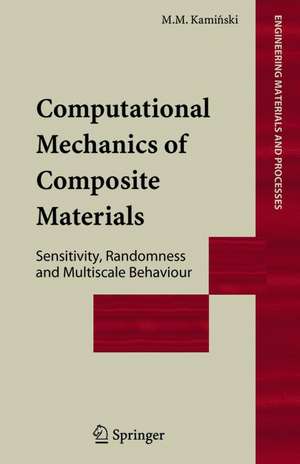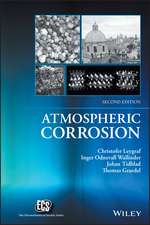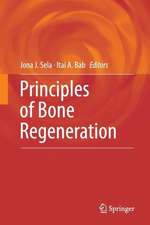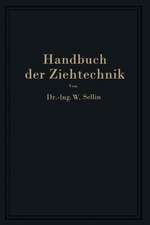Computational Mechanics of Composite Materials: Sensitivity, Randomness and Multiscale Behaviour: Engineering Materials and Processes
Autor Marcin Marek Kaminskien Limba Engleză Hardback – feb 2005
Features:
Programs for the probabilistic homogenisation of composite structures with finite numbers of components allow composites to be treated as homogeneous materials with simpler behaviours.
Treatment of defects in the interfaces within heterogeneous materials and those arising in composite objects as a whole by stochastic modelling.
New models for the reliability of composite structures.
Novel numerical algorithms for effective Monte-Carlo simulation.
Computational Mechanics of Composite Materials will be of interest to academic and practising civil, mechanical, electronic and aerospatial engineers, to materials scientists and to applied mathematicians requiring accurate and usable models of the behaviour of composite materials.
| Toate formatele și edițiile | Preț | Express |
|---|---|---|
| Paperback (1) | 935.10 lei 6-8 săpt. | |
| SPRINGER LONDON – 22 oct 2010 | 935.10 lei 6-8 săpt. | |
| Hardback (1) | 939.58 lei 6-8 săpt. | |
| SPRINGER LONDON – feb 2005 | 939.58 lei 6-8 săpt. |
Din seria Engineering Materials and Processes
- 18%
 Preț: 934.49 lei
Preț: 934.49 lei - 15%
 Preț: 635.42 lei
Preț: 635.42 lei - 18%
 Preț: 1217.02 lei
Preț: 1217.02 lei - 18%
 Preț: 1359.63 lei
Preț: 1359.63 lei - 18%
 Preț: 1216.90 lei
Preț: 1216.90 lei - 18%
 Preț: 1795.17 lei
Preț: 1795.17 lei - 5%
 Preț: 676.33 lei
Preț: 676.33 lei - 15%
 Preț: 634.11 lei
Preț: 634.11 lei - 18%
 Preț: 1207.87 lei
Preț: 1207.87 lei - 15%
 Preț: 625.92 lei
Preț: 625.92 lei - 18%
 Preț: 936.02 lei
Preț: 936.02 lei - 18%
 Preț: 1196.85 lei
Preț: 1196.85 lei - 20%
 Preț: 331.36 lei
Preț: 331.36 lei - 20%
 Preț: 557.20 lei
Preț: 557.20 lei -
 Preț: 396.94 lei
Preț: 396.94 lei - 15%
 Preț: 633.32 lei
Preț: 633.32 lei - 18%
 Preț: 940.37 lei
Preț: 940.37 lei - 18%
 Preț: 768.13 lei
Preț: 768.13 lei - 15%
 Preț: 629.29 lei
Preț: 629.29 lei - 23%
 Preț: 641.97 lei
Preț: 641.97 lei - 18%
 Preț: 925.63 lei
Preț: 925.63 lei - 18%
 Preț: 929.36 lei
Preț: 929.36 lei - 18%
 Preț: 926.55 lei
Preț: 926.55 lei - 15%
 Preț: 624.63 lei
Preț: 624.63 lei - 18%
 Preț: 1360.41 lei
Preț: 1360.41 lei - 15%
 Preț: 634.11 lei
Preț: 634.11 lei - 18%
 Preț: 1201.80 lei
Preț: 1201.80 lei - 18%
 Preț: 1358.54 lei
Preț: 1358.54 lei - 18%
 Preț: 929.36 lei
Preț: 929.36 lei - 15%
 Preț: 634.74 lei
Preț: 634.74 lei - 18%
 Preț: 1524.89 lei
Preț: 1524.89 lei - 24%
 Preț: 848.84 lei
Preț: 848.84 lei - 18%
 Preț: 1096.32 lei
Preț: 1096.32 lei - 15%
 Preț: 621.89 lei
Preț: 621.89 lei - 18%
 Preț: 932.78 lei
Preț: 932.78 lei
Preț: 939.58 lei
Preț vechi: 1145.83 lei
-18% Nou
Puncte Express: 1409
Preț estimativ în valută:
179.87€ • 184.99$ • 149.22£
179.87€ • 184.99$ • 149.22£
Carte tipărită la comandă
Livrare economică 19 februarie-05 martie
Preluare comenzi: 021 569.72.76
Specificații
ISBN-13: 9781852334277
ISBN-10: 1852334274
Pagini: 438
Ilustrații: XVIII, 418 p.
Dimensiuni: 155 x 235 x 26 mm
Greutate: 0.74 kg
Ediția:2005
Editura: SPRINGER LONDON
Colecția Springer
Seria Engineering Materials and Processes
Locul publicării:London, United Kingdom
ISBN-10: 1852334274
Pagini: 438
Ilustrații: XVIII, 418 p.
Dimensiuni: 155 x 235 x 26 mm
Greutate: 0.74 kg
Ediția:2005
Editura: SPRINGER LONDON
Colecția Springer
Seria Engineering Materials and Processes
Locul publicării:London, United Kingdom
Public țintă
ResearchCuprins
Mathematical Preliminaries.- Elasticity Problems.- Elastoplastic Problems.- Sensitivity Analysis for Some Composites.- Fracture and Fatigue Models for Composites.- Reliability Analysis.- Multiresolutional Wavelet Analysis.
Notă biografică
Marcin Kaminski teaches theoretical mechanics, strength of materials and computational and numerical methods in civil engineering as the Chair of Mechanics and Materials at the Technical University of Lodz. He has published over seventy articles in peer-reviewed academic journals and several books and has given many conference presentations. He spent a sabbatical leave at Rice University in Texas as the fellow of the Foundation for Polish Science in 1999/2000. He received the John Argyris Award in computational mechanics from ECCOMAS and Elsevier in 2001, the JT Oden Faculty Fellowship in the University of Texas at Austin in 2004 and is a member of IASS, SIAM, GAMM and IACM.
Professor Kaminski's research interests include: probabilistic and stochastic methods in computational mechanics of solids, structures and fluids, numerical analysis of stochastic reliability in engineering structures, the implementations of probabilistic procedures into FEM, BEM and FDM-based computer programs, computational modeling of stochastic aging processes in engineering and applied science, homogenization methods for composite materials as well as the software development for stochastic symbolic computations using MAPLE.
Professor Kaminski's research interests include: probabilistic and stochastic methods in computational mechanics of solids, structures and fluids, numerical analysis of stochastic reliability in engineering structures, the implementations of probabilistic procedures into FEM, BEM and FDM-based computer programs, computational modeling of stochastic aging processes in engineering and applied science, homogenization methods for composite materials as well as the software development for stochastic symbolic computations using MAPLE.
Textul de pe ultima copertă
Composite materials play a vital role in modern engineering from aerospace to nuclear devices. Computational mechanics endeavours to provide precise numerical models of composites. More recently, it has been necessary to take account of the stochastic nature of their behaviour indicated by experiment. The approach of Computational Mechanics of Composite Materials lays stress on the advantages of combining theoretical advancements in applied mathematics and mechanics with the probabilistic approach to experimental data in meeting the practical needs of engineers.
Features:
Programs for the probabilistic homogenisation of composite structures with finite numbers of components allow composites to be treated as homogeneous materials with simpler behaviours.
Allows treatment of defects in the interfaces within heterogeneous materials and those arising in composite objects as a whole by stochastic modelling.
Provides new models for the reliability of composite structures.
Propounds novel numerical algorithms for more effective Monte-Carlo simulation.
Computational Mechanics of Composite Materials will be of interest to academic and practising civil, mechanical, electronic and aerospatial engineers, to materials scientists and to applied mathematicians requiring accurate and usable models of the behaviour of composite materials.
The Engineering Materials and Processes series focuses on all forms of materials and the processes used to synthesise and formulate them as they relate to the various engineering disciplines. The series deals with a diverse range of materials: ceramics; metals (ferrous and non-ferrous); semiconductors; composites, polymers biomimetics etc. Each monograph in the series will be written by a specialist and will demonstrate how enhancements in materials and the processes associated with them can improve performance in the field of engineering in which they are used.
Features:
Programs for the probabilistic homogenisation of composite structures with finite numbers of components allow composites to be treated as homogeneous materials with simpler behaviours.
Allows treatment of defects in the interfaces within heterogeneous materials and those arising in composite objects as a whole by stochastic modelling.
Provides new models for the reliability of composite structures.
Propounds novel numerical algorithms for more effective Monte-Carlo simulation.
Computational Mechanics of Composite Materials will be of interest to academic and practising civil, mechanical, electronic and aerospatial engineers, to materials scientists and to applied mathematicians requiring accurate and usable models of the behaviour of composite materials.
The Engineering Materials and Processes series focuses on all forms of materials and the processes used to synthesise and formulate them as they relate to the various engineering disciplines. The series deals with a diverse range of materials: ceramics; metals (ferrous and non-ferrous); semiconductors; composites, polymers biomimetics etc. Each monograph in the series will be written by a specialist and will demonstrate how enhancements in materials and the processes associated with them can improve performance in the field of engineering in which they are used.
Caracteristici
The reader will be shown the most up-to-date methods for the accurate and practical modelling of a very important group of materials. The associated website will allow the reader to keep himself up-to-date with the latest advances in the modelling techniques presented even when the book itself has been superceded. Includes supplementary material: sn.pub/extras













